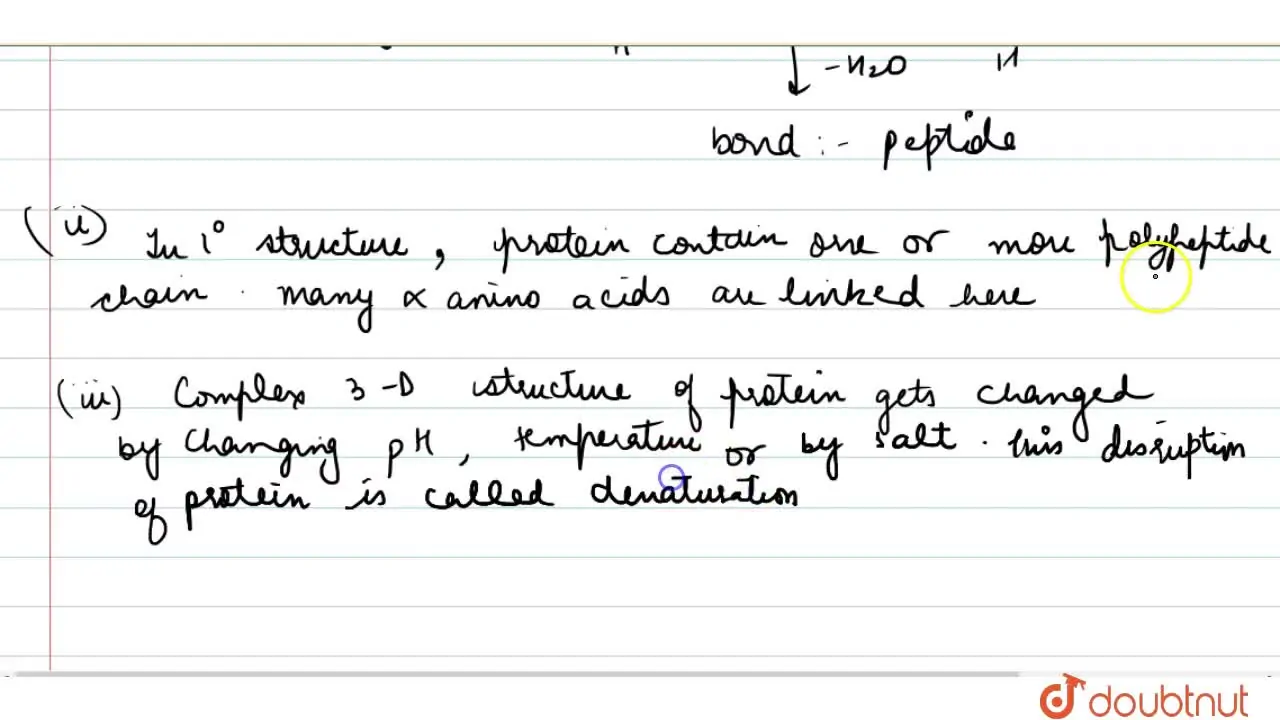Define the following as related to proteins :
(i) Peptide linkage
(ii) Primary structure
(iii) Denaturation
(i) Peptide bond. Proteins are condensation polymers of -amino acids in which the same or different -amino acids are connected by peptide bonds. Chemically, a peptide bond is an amide linkage formed between group of one -amino acid and group of the other -amino acid by loss of a molecule of water. For example,

(ii) Primary strcuture : Proteins may contain one or more polypeptide chains. Each polypeptide chain has a large number of - amino acids which are linked to one another in a specific sequence. The specific sequencein which the various -amino acids present in a protein are linked to one another is called is primary structure. Any change in the sequence of -amino acids creates a different protein. The gerneral primary structure of a protein is given.
(iii) Denaturation : Each proteins in the biological system has a unique three - dimensional structure and has specific biological activity. This is called native form of a protein. When a protein in its native form is subjected to physical changes in temperature, p H etc .hydrogen bonds are broken. Due to cleavage of hydrogen bonds, unfolding of protein molecule occurs and the protein loses its biological activity. This loss of biological activity is called denaturation. As a result of denaturation, globular proteins (soluble in ) are converted into fibrous proteins (insoluble in ). In other words , denaturation leads to coagulation. That is why coagulated proteins are also called denatureated proteins.
The most common example of denaturation of proteins is the coagulation of albumin present in the while of an egg. When the egg is boiled hard , the soluble globular protein present in it is denatured and is converted into insoluble fibrous protein. Another example is curding of milk which is caused due to formation of lactic acid by bacteria present in milk.
Related Playlists
- BOOK - PRADEEPCHAPTER - BIOMOLECULES EXERCISE - NCERT (EXEMPLAR PROBLEMS) (With answers, Hints And Solution) (Multiple Choice Questions-I )19videos
BIOMOLECULES
- BOOK - PRADEEPCHAPTER - BIOMOLECULES EXERCISE - NCERT (EXEMPLAR PROBLEMS) (With answers, Hints And Solution) (Multiple Choice Questions-II )9videos
BIOMOLECULES
- BOOK - PRADEEPCHAPTER - BIOMOLECULES EXERCISE - NCERT (QUESTIONS AND EXERCISES) WITH ANSWERS (NCERT INTEXT UNSOLVED QUESTIONS)8videos
BIOMOLECULES
- BOOK - PRADEEPCHAPTER - APPENDIXEXERCISE - MODEL TEST PAPER <br> (Section C )15videos
APPENDIX
- BOOK - PRADEEPCHAPTER - CHEMICAL KINETICSEXERCISE - ADVANCED PROBLEMS FOR COMPETITIONS14videos
CHEMICAL KINETICS
Similar Questions
Define the following as related to proteins:
(i) Peptide linkage (i) Primary structure (iii) Denaturation.View SolutionDefine the following terms as related to proteins :
(i) Peptide linkage (ii) Primary structure .
(iii) Denaturation.View SolutionDefine the following as related to proteins.
(i) peptide linkage
(ii) Denaturation.View SolutionDefine the following terms in relation to proteins :
Peptide linkageView SolutionDefine the following terms in relation to proteins :
(i) Peptide linkage . (ii) Denaturation.View SolutionDefine the following terms in relation to proteins :
DenaturationView SolutionDefine the following term in relation to proteins :
(i) Peptide bond
(ii) Denaturation of proteins.View SolutionDescribe the following
(i) Glycosidic linkage
(ii) Peptide linkage.View SolutionDefine a 'Peptide linkage'.
View SolutionWhat is meant by
(i) peptide linkage
(ii) biocatalystsView Solution


